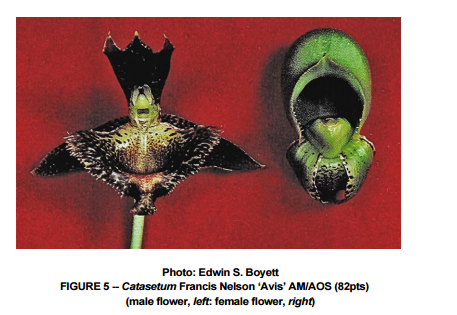The Catasetum orchid genus has unisexual flowers, either male or female (they look different); which type appears is controlled by the lighting. If grown in low lighting like a Phalaenopsis, male flowers will appear; if grown in high lighting like a Cattleya they’ll have female flowers. The two flower types look different, so there will probably be one or the other that you’re looking for for the particular species you’re growing. (The male flowers are usually preferred, as they often have small, green, hooded female flowers.)

For this particular family of orchids, after blooming occurs the plant goes into a dormancy/resting period where the leaves WILL YELLOW and DROP. This is completely normal. This resting period allows the plant to conserving its energy for the next growing cycle. Watering should also be reducing during dormancy.
Which type of flower a plant produces is determined by the conditions under which it grows. Male and female flowers are markedly different in size and color. At first, taxonomists even thought they were dealing with different species, a puzzle which Charles Darwin resolved when writing Fertilisation of Orchids. There are rare cases in which a single plant in intermediate conditions will produce both male and female flowers.
Many of these species are known to germinate in ant nests high in the canopy and host ant colonies, which provide the plants with an abundant supply of nitrogen, and they also host ants in cultivation frequently. Most of these species are considered moderately difficult to maintain in cultivation without a greenhouse or wardian case and some of them defy cultivation. Most of them cannot tolerate dryness and some of them have very specific temperature requirements. Some of these species are ant plants and attract ant colonies and can become a nuisance in cultivation.
http://www.orchid-care-tips.com/catasetum.html
http://www.akatsukaorchid.com/store/pg/50-Catasetum-Relatives-Care.aspx
https://en.wikipedia.org/wiki/Catasetum
http://www.aos.org/orchids/culture-sheets/catasetum.aspx
http://catasetinae5.blogspot.in/p/introduction-to-catasetinae.html
video
